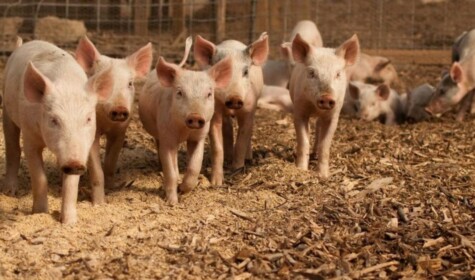Joel Salatin, has become something of a celebrity in the local food movement. The outspoken American farmer, who featured in Michael Pollan’s book, An Omnivore’s Dilemma, after refusing to ship Pollan meat outside it’s bioregion, now writes and tours himself. His hard-hitting views on the industrial food system were heard earlier this year in London, but it’s his innovative and highly successful farming techniques, which are now gaining global attention.
Salatin is an advocate of a system of agriculture called mob-grazing. It is an intensive rotational grazing system, which is based on the idea of grazing a large amount of cattle on a small amount of land, for a very short period of time. Advocates say the system reflects nature, where wild animals arrive in herds, eat and move on, much like bison or wilderbeast.
 In Salatin’s case, he grazes 300 cows on a quarter of an acre for a day and then shifts them to the next field. This partial grazing of the land allows the remaining grass to feed the root system and the pasture to grow back quicker and stronger, “much like a teenage growth spurt,” says Salatin. On Salatin’s farm, this regenerative process is supported by following the departure of the cows with the arrival – three days later – of chickens, in a unique mobile coop he calls the “egg mobile”.
In Salatin’s case, he grazes 300 cows on a quarter of an acre for a day and then shifts them to the next field. This partial grazing of the land allows the remaining grass to feed the root system and the pasture to grow back quicker and stronger, “much like a teenage growth spurt,” says Salatin. On Salatin’s farm, this regenerative process is supported by following the departure of the cows with the arrival – three days later – of chickens, in a unique mobile coop he calls the “egg mobile”.
The chickens spread the natural fertiliser left behind by the cows by scratching it into ground. They also eat any bugs and parasites, which have hatched. The chickens are followed by broilers (meat chickens) and turkeys, which all play their unique part in ensuring the soil receives the maximum amount of nutrients needed to restore its fertility. Salatin maintains that if you can smell the manure on a farm “you’re smelling mis-management”.
The system allows Salatin to graze four times as many cattle as on a conventional farm, thus saving on feeding costs. In stark contrast to neighbouring farmers in his corner of Virginia, Salatin has never bought a bag of chemical fertiliser or seed in his life. “We completely rely on large scale composting, controlled grazing and the symbiotic relationship between the species to make our farm work”.
As a result, Salatin’s 500 acre, multi-species farm, called Polyface, has become a pilgrimage site for many interested in alternative methods of agriculture – although it remains a humble looking place, with a white clapboard farmhouse and a minimum of staff. Farming was in the blood for Joel, his father and grandfather both farmed but they have always done so in ecological way. “My grandfather used to read Rodale Organic Gardening and Farming magazine so we didn’t go through any conversion experience, we were just always weird,” he laughs.
Joel himself went away from farming to become a newspaper journalist, but after meeting and marrying his wife in 1982 he came back, determined to make a living as a full-time farmer. His method of agriculture comes, he says, from a deep respect of nature and observing the failures of large scale, industrial farming around him. The success at Polyface is in the figures – Joel boasts that he can now get 400 cow days to an acre – a cow day is what one cow will eat in a day – where the country average is 80. In money terms this translates to the farm exceeding sales of $1.5 million annually.
But the question remains; could mob-grazing feed the world? Joel’s answer is that not only could it feed the world but it’s the only system that will. “The industrial food paradigm views life from a mechanical point of view. Food is a machine, and the way they go about producing it depletes the soil and burns up energy. Our way of producing food is based on abundance, not depletion. We rejuvenate the soil and lock up carbon so that food can continue to be produced”.
Encouraging farmers to turn to mob-grazing is one answer to producing more food, but Joel believes there’s a message here for all of us. “We need to create a more integrated food system and start embedding food in our houses, in our backyards and in our communities,” he says.
He points out that if every kitchen had its own chickens, there would be no need for a poultry industry in the first place. Like with most things Joel Salatin says, his self-confessed “lunatic” rantings make more sense than many of the other ideas being put forward to our solve our apparent “food shortage problems”. Let’s hope the enthusiasm for his methods continues.



